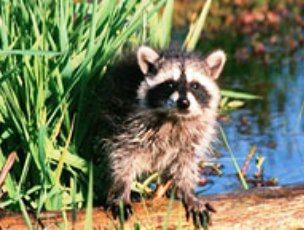Discover Florida Nature
It's time to explore the natural Florida


|
|
|
|
|
 The
raccoon, or simply "coon", is one animal that most people are
well-acquainted with. Raccoons are common throughout the state and occur
everywhere there are trees, the cavities of which they often use. The
raccoon (Procyon lotor) is about the size of a small dog, and
is most notable for its black mask and bushy ringed tail. The
raccoon, or simply "coon", is one animal that most people are
well-acquainted with. Raccoons are common throughout the state and occur
everywhere there are trees, the cavities of which they often use. The
raccoon (Procyon lotor) is about the size of a small dog, and
is most notable for its black mask and bushy ringed tail. There is no mistaking a raccoon for any other animal. Its stout, bear-like body, prominent black mask and heavily furred, ringed tail all are distinctive. Adult raccoons are about 2 to 3 feet long (including their 10-inch tail) and weigh anywhere from 10 to 30 pounds. Larger animals sometimes are recorded, but Florida raccoons tend to be smaller than those farther north. Their color generally is a grizzled salt-and-pepper gray and black with a light belly. Often the "white" hairs are noticeably yellowish. Both all-black and all-white animals sometimes occur. Raccoons are one of the few wild species that appears to have benefited from contact with humans, and they have adapted remarkably well to life in our cities and towns. Such synanthropes—wild animals who are willing and able to live among humans—are usually generalists, tolerating widely different habitats and eating many different foods. Studies show that the densities raccoons achieve in urban areas can be up to 20 times that typical in rural environments. Raccoons are not fussy about their choice of food. Although classified as a carnivore, the raccoon eats as much or more plant as animal matter during the year. When fruits, acorns, vegetables and seeds are ripe and available, they will feed heavily on them. At other times and places they will specialize in eggs, insects, crayfish, frogs, fish and small mammals. They'll eat dead animals that they encounter; they'll raid bird feeders and pet food bowls when they're kept full; and they'll check out garbage cans that aren't secured. Raccoons are usually active at night, and by day they retire to dens or resting sites. Dens are made above ground in tree cavities, chimneys and attics, as well as underground in old woodchuck burrows, storm sewers or crawl spaces under buildings. When they feel secure enough, raccoons may simply lie in thickets or swamps on open ground.  At
least as intelligent as cats or dogs, raccoons possess far greater
manual dexterity as well as a highly developed sense of touch. In fact,
the word "raccoon" is derived from arakun, an Algonquin word
meaning "he scratches with his hands." It was once thought that
raccoons' familiar "washing" of foods demonstrated hygienic instincts.
But in truth, raccoons don't wash everything they eat. They manipulate
food, dunking and soaking it when water is available, and so appear to
be washing it. However, when water is not convenient, they use many of
the same motions in handling food. The behavior probably more accurately
reflects a need to tactually experience things than it does to clean
them. At
least as intelligent as cats or dogs, raccoons possess far greater
manual dexterity as well as a highly developed sense of touch. In fact,
the word "raccoon" is derived from arakun, an Algonquin word
meaning "he scratches with his hands." It was once thought that
raccoons' familiar "washing" of foods demonstrated hygienic instincts.
But in truth, raccoons don't wash everything they eat. They manipulate
food, dunking and soaking it when water is available, and so appear to
be washing it. However, when water is not convenient, they use many of
the same motions in handling food. The behavior probably more accurately
reflects a need to tactually experience things than it does to clean
them.Breeding occurs first when they are one year old. Normally, one litter is born each year. In Florida, this generally occurs in March and April. Litters average about 3 to 4 young, though as many as 7 have been recorded. Newborn raccoons' eyes remain closed until about 20 days old, they are weaned at 10 to 12 weeks, and the offspring may stay with their mother until they are 10 months old. Captive raccoons have been known to live for more than 20 years. However, the species' life expectancy in the wild is only 1.8 to 3.1 years, depending on the local conditions in terms of traffic volume, hunting, and weather severity. It is not unusual for only half of the young born in one year to survive a full year. After this point, the annual mortality rate drops to between 10 and 30%. Young raccoons are vulnerable to losing their mother and to starvation, particularly in long and cold winters. The greatest problem with raccoons is disease. Raccoons are known to carry a wide variety of diseases. Most of these are harmless to them and to people, but a few, such as distemper, can kill raccoons when their populations get too dense. These diseases also can infect pets that are not vaccinated. Rabies is another such disease. The risk of rabies is small (less than 1 out of 200 raccoons in the wild have been exposed to rabies), but the risk should never be taken lightly. Raccoons are wild animals and should never be treated as pets. |
|
|
Advertise | Privacy Statement | Dog Encyclopedia | Video |Contact | Alaska Nature |
|